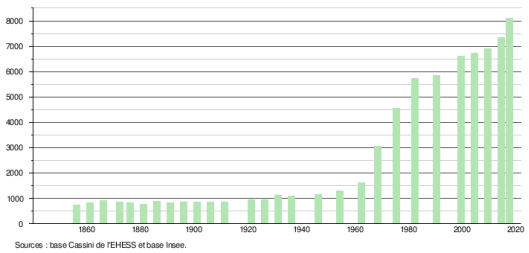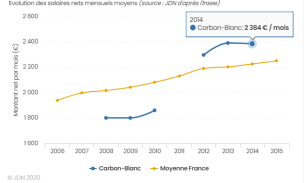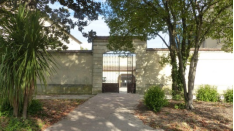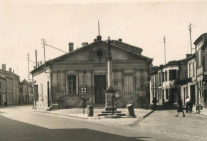Carbon-Blanc, Gironde, Nouvelle-Aquitaine 作者: 来源: 发布时间:2021-06-10
I.Population and Area
Total Area: 3.86 km2
Population in 2017: 8091
Population Density: 2096 /km2

Histogram of demographic change
II.Natural Geography (environment and resources)
Carbon-Blanc is a town in southwestern France, located in the Gironde department, in the Nouvelle-Aquitaine region.

Municipality of the extreme north of Entre-deux-Mers, in the peninsula formed by the confluence between Dordogne and Garonne, Carbon-Blanc is also located in the north of the urban area of Bordeaux and in its urban unit.
Communication routes and transport:
1)Highway:
Access by the A10 motorway, exits 43 and 44.
2)TER train Nouvelle-Aquitaine:
The city has a station (Gare de Sainte-Eulalie - Carbon-Blanc) located on the line from Chartres to Bordeaux-Saint-Jean and served by the TER Nouvelle-Aquitaine.
3)TBM network:
The Transports Bordeaux Métropole (TBM) network serves the municipality through line A of the Bordeaux tramway, which has its terminus to the south of the municipality, as well as by bus lines 7, 90, 92 and 93. In the evening, in addition to line 7, the town is served by the Flexo 50.
4)TransGironde network:
Lines 201, 202 and 301 leave from the Buttinière tram station, cross the town and serve Blaye, Saint-Ciers-sur-Gironde, Pleine-Selve, Sante-Eulalie, Izon and Libourne.
III.Economy
Employment rate (%): 78 (2017)
Poverty rate by age group of the tax advisor(%): 12 (2017)
Average employment income (€):2 384 net per month (28 606 net per year)(2014)

Evolution of average monthly net wages
Sources : http://www.journaldunet.com/business/salaire/carbon-blanc/ville-33096
https://insee.fr/fr/statistiques/2011101?geo=COM-33096#tableau-REV_G1
IV.Industrial Characterisitics
Sectors of activity most represented in Carbon-Blanc
The table below lists the five sectors of activity with the most companies in Carbon-Blanc during the period from 24/09/2019 to 24/09/2020 as well as the share of each sector on the number total of companies in the municipality.
Sector of activity | Number of companies | Share of companies |
Rental and operation of own or leased real estate | 210 | 21.0% |
Other human health activities | 55 | 5.5% |
Finishing work | 50 | 5.0% |
Electrical, plumbing and other installation work | 42 | 4.2% |
Activities of other membership organizations | 40 | 4.0% |
The companies that generate the most turnover in Carbon-Blanc
The list displayed below presents the companies located in Carbon-Blanc and which report the highest 2019 turnover in the municipality.
1)Cheval Quancard
2)Portocork France
Cheval Quancard:
SCI COTEAUX DE LA RIVE DROITE, a real estate company, has been in business for 36 years.
Based in CARBON-BLANC (33560), it specializes in the field of land rental and other real estate.
Societe.com lists 1 establishment and the last notable event of this company dates from 06-03-2018.
CHEVAL QUANCARD represented by Roland QUANCARD is manager of the company SCI COTEAUX DE LA RIVE DROITE.
Portocork France:
PORTOCORK FRANCE, a simplified joint-stock company, has been in business for 14 years.
Established in CARBON-BLANC (33560), it specializes in the wholesale trade (inter-company trade) of other household goods. Its workforce is between 6 and 9 employees.
In 2019 it achieved a turnover of € 4,865,700.00.
The balance sheet total decreased by 1.75% between 2018 and 2019.
Societe.com lists 2 establishments and the last notable event of this company dates from 05/14/2018.
PORTOCORK INTERNATIONAL SA represented by Antonio MESQUITA DE SOUSA is president of the company PORTOCORK FRANCE.
Sources: http://entreprises.lefigaro.fr/carbon-blanc/ville-33096
https://www.societe.com/societe/portocork-france-491286225.html
https://www.societe.com/societe/sci-coteaux-de-la-rive-droite-330296419.html
V.Attractions
1.The Favols Park

Favols (name which comes from the Latin "favolibus": place of passage) is a very old seigniory which depended on the barons of Montferrand. Built on a slight eminence along the slope which descends from Bassens to the Gua stream, a small fortress (bastide) was to watch the passage on the road which passes through the village of Carbon-Blanc.
Several lords succeeded each other from Sauvat de Ferrand in 1588 (who was related to Michel de Montaigne's mother) to Jean Luc de Barret, squire and clerk in the parliament of Guyenne then his widow Marie de Maurel on the eve of the Revolution.
Then Favols passed into many hands: among the most notable are Jacques Lhortet-Meunier, mayor of Bassens-Carbon-Blanc from 1842 to 1848, justice of the peace at Saint André de Cubzac; then his son-in-law Pierre (known as Auguste) Douat, long-distance captain; and the latter's son-in-law, Jean Fouquet, notary.
The last owners, the Francolon family and their heirs, sold in 1981 the castle and what was left of the estate to a low-cost housing company which transferred a large part of it to the commune of Carbon-Blanc, including the castle and the farm. adjoining and the park.
The buildings of the castle date from the 19th century. They are arranged around a square courtyard which opens to the east through a wrought iron gate: the south wing housed the masters' quarters; the north wing the stables, barns and sheds; and the west wing the vat room and chaix. Because Favols was in the 19th century and until the middle of the 20th century the largest wine estate in the town.
Restored, the castle buildings have become the Favols cultural center which includes the media library, a multipurpose room, a cinema and the music school. The farm has become the Maison pour Tous Ludovic Trarieux: it houses the city's social services.
The park, covering an area of over 4 ha, has been redeveloped to be a place of relaxation in the heart of the city.
Another part of the estate was sold to the department, which built a new gendarmerie there.
And the HLM company built a real estate complex centered on a square in a style that wanted to recall the medieval bastides of Entre deux mers, while in the context of a ZAC (Zone d'Aménagement Concerté) the school elementary Barbou was restructured.
2.Château Brignon
Château Brignon (or du Brugnon): castle which dates from the seventeenth century and was increased in the nineteenth; the land was initially agricultural land and the castle, bought by the town at the beginning of the 21st century was first transformed into a cultural center dedicated to comics including a creation workshop, an exhibition hall and a restoration. Since 2014, it has housed a school of entrepreneurs and a business incubator and hosts many public and private events in its meeting room. A private nursery has also been opened in one of the outbuilding.
3.Plaine du Faisan
Plaine du Faisan: a vast nature reserve to the north of the town, it takes its name from Jacques Faizan, merchant and bourgeois of Bordeaux who bought at the end of the 16th century this land where part of the medieval fortress of the barons of Montferrand; a castle destroyed at the end of the twentieth century stood on the site where the college was built; sports grounds and a fitness trail have been set up in part of the plain.
4.Saint-Paulin Church
Saint-Paulin Church: neo-Gothic style church whose construction is linked to the founding of the town of Carbon-Blanc; it was initially a simple chapel, enlarged in 1852 to become a parish church.
Sources : https://www.carbon-blanc.fr/ma-ville/histoire-patrimoine/patrimoine.html
VI.History
Carbon-Blanc is not only the smallest municipality in the Bordeaux metropolis by its size (less than 4 square kilometers), but it is also one of the youngest since its creation dates from 1853, the date on which a decree from Napoleon III separated the territory from that of Bassens. But its history is very old!

A Gallo-Roman villa
The first traces of human occupation date back to Roman antiquity. A villa then occupies the bottom of the slope which leads to the Gua valley, where the current municipal center is located. Its ruins were discovered at the beginning of the 20th century in the area of Flanders, then studied again in 2014, as part of preventive archeology. It presumably extends under part of the present village, north of Rue Thérèse.
Horrors and misfortunes of the Middle Ages
Destroyed by the successive invasions of the Visigoths and the Vikings, only ruins remain when in 1141 Sicaire, a monk of the order of Citeau, created in the valley of the Gua, on land belonging to the Baron de Montferrand, the abbey of Bonlieu and encourages inhabitants to come and settle near the ruins of the Gallo-Roman villa in order to enhance the area. Thus was born the first village of Carbon-Blanc, then called “Territoire des Reliques” (or “ruins”)
But the many wars of the Middle Ages reduced the work undertaken to nothing. When peace returned, the Baron de Montferrand and the Abbé de Bonlieu appealed in 1500 to new inhabitants, asking them to come and repopulate the old "Territory of the Relics", now called "the Charbon-Blanc". Why this name? Maybe because the basement contains a practically ubiquitous white clay? Perhaps because there is a hospital near the Abbey of Bonlieu, in which, thanks to the water from the Ladres stream, a tributary of the Gua, one can be cured of a skin disease known as anthrax?
Prosperity of Modern Times
The prosperity of Carbon-Blanc dates from the 18th century. The great royal road from Paris to Bordeaux, developed by the will of King Louis XV now crosses the town which is being transformed. The old public street which goes from the abbey of Bonlieu to the last Roman remains (the streets of the Moulin and Thérèse today) is doubled by the great royal road (the avenue Austin Conte), delimiting the current Thérèse esplanade.
At the same time, near Carbon-Blanc as on all the right bank of the Garonne of the "bourgeois and privileged of Bordeaux" are built beautiful residences in the middle of their vineyards: they serve them as summer residence and thus allow them to escape the heat of the city. The most important are those of Salazard, Sourd, Favols, Brignon and Faisan.
Birth of the town of Carbon-Blanc in the 19th century
In 1789, plans were made to create a town with Carbon-Blanc as its capital (with the chapel of the Abbey of Bonlieu as a parish church) by taking land on both banks of the Gua in the parishes of Bassens and Sainte-Eulalie. . Eventually, this project was abandoned and the Abbey of Bonlieu was auctioned off and largely destroyed. The parish of Bassens becomes the municipality of Bassens-Carbon-Blanc. The town of Carbon-Blanc, larger than that of Bassens, was chosen as the capital of the town (and of the canton), but the parish church remained in Bassens.
Finding that they had too far to go to attend religious services, the inhabitants of Carbon-Blanc obtained the construction of a chapel in 1848 (dedicated to Saint Paulin), then the transformation of the chapel into a parish church the following year and finally the creation of a new commune in 1853.
Recent transformations
Everything changed in the 1960s. The vineyard was largely destroyed by the snow and frost of 1957 and 1958. As the land brought in less, the owners were tempted to sell their property. At the same time, in 1967, the construction of the Aquitaine Bridge enabled easier relations with Bordeaux and encouraged inhabitants of the left bank to settle on the right bank.
Thus began to develop the subdivisions of individual houses: the oldest is that of Flanders (before the Second World War), then comes the Beausite city in 1956 (rue Pasteur), followed by many others. We also built a few apartment buildings: the first operations were that of Mesquita in 1962 followed by that of Triviaux; the most important is located in the Favols district in the 1980s with the construction not only of housing but also of a market and commercial premises. The movement continues at the beginning of the 21st century. The population of the municipality thus drops from just over 1,000 inhabitants in the interwar period to nearly 8,000 today.
The smallest municipality in the metropolis, Carbon-Blanc is thus one of the municipalities with the highest population density. But, while being firmly anchored in the great metropolitan urban complex, it is keen to retain its character as a garden city and a center of activities and shops, inherited from its rich past.
Sources: https://www.carbon-blanc.fr/ma-ville/histoire-patrimoine/histoire.html
VII.Other information
Activity areas :
Economic center of Château Brignon
At the gates of Bordeaux, located at Château Brignon in Carbon Blanc, the Economic Pole offers support for business creation and development, articulated into 4 poles of activity. A structure created by the city of Carbon-Blanc in partnership with Bordeaux Métropole through the establishment of a business incubator and a skills center for business manager training. Our structure is oriented towards the creation, training and supervision of companies linked to innovative activities and high added value services. And support for people looking for work and retraining.
Our goal: to accompany and support project leaders, business creators, job seekers and / or retraining to structure and develop their project.
Our mission: to be a real strategic springboard for the development and competitiveness of the territory.
Delphine GUIVY: 06 37 12 34 50 - contact@comuneparenthese.fr
La Mouline business area
Within Bordeaux Métropole, the City of Carbon-Blanc has always worked for efficient economic development that creates jobs.
At the same time, the Municipality has always shown concern for an economic development that respects both people, the environment and the quality of life of residents.
This balance between economic development and respect for the identity of Carbon-Blanc is a major focus of the economic policy defended by the Municipality.
The territory of the formerly rural municipality is now 90% urbanized. Only 6 hectares of vines falling under the appellation of "Première Côtes de Bordeaux" continue to be cultivated.
Local commerce is mainly located along the CD911 (avenue Austin Conte and avenue de Bordeaux) as well as in the new town center in Favols. This offers a wide range of services to the inhabitants of the Commune and to those of neighboring towns (Sainte – Eulalie, Ambarès, Saint-Loubès, etc.).
La Mouline is a Concerted Development Zone (ZAC). This ZAC is devoted to a very targeted occupation: hosting industrial activities. We find Sepalumic, Cheval Quancard, Lahaye transports, Messer Air Liquide ...
Created in 1979 on 44 ha, it was developed by Gironde Développement, Société d'Économie Mixte (SEM). This public developer built the roads and networks on the site. In the end, the full commercialization of the land will have taken 25 years.
Sources: https://www.carbon-blanc.fr/ma-ville/vie-economique/zone-dactivites.html
VIII.Contact information
Carbon-Blanc town hall address :
Town Hall of Carbon-Blanc
BP 37 Avenue Vignau-Anglade
33564 Carbon-White Cedex
Mayor : Alain Turby (Mandate : 2014-2020)
Mail: contact@ville-bassens.fr
Phone number: 05 57 80 81 57
Fax: 05 57 80 81 58
Website : http://www.ville-bassens.fr
Sources : http://www.cartesfrance.fr/carte-france-ville/33096_Carbon-Blanc.html
